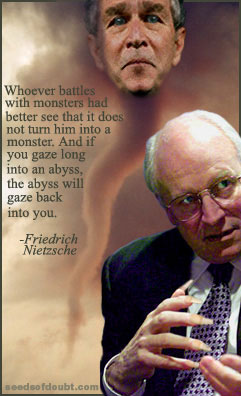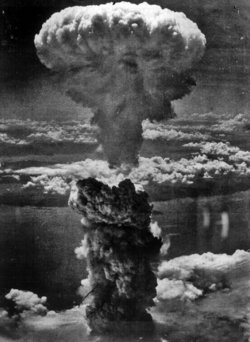By Ben Friedman, AlterNet
Posted on February 9, 2006, Printed on February 9, 2006
Conventional wisdom says that none of us are safe from terrorism. The truth is that almost all of us are. The conventional belief is that in response to terrorism, the federal government has spent massive sums on homeland security. The fact is that the increased federal spending on homeland security since September 11 pales in comparison to increases in the U.S. defense budget. But homeland security has costs beyond spending, costs that conventional thinking rarely considers. U.S. homeland security policy conjures up a flawless enemy that could strike at any moment, in any place. That policy institutionalizes the fears terrorists created and harms liberal values.
Most homeland security experts say that Hurricane Katrina's flooding of New Orleans shows how vulnerable we are to terrorists. In fact, it shows that most Americans have better things to worry about. By any statistical measure, the terrorist threat to America has always been low. As political scientist John Mueller notes, in most years allergic reactions to peanuts, deer in the road, and lightening have all killed about the same number of Americans as terrorism. In 2001, their banner year, terrorists killed one twelfth as many Americans as the flu and one fifteenth the number killed by car accidents.
Most experts dismiss this history. They contend that because both weapons technology and Sunni extremism are spreading, the terrorist danger is ahistorical. But while both these trends are real, we should not leap to the conclusion that the threat is growing or greater than more mundane dangers. There is no obvious reason to believe that September 11 was the start of an era of ever deadlier terrorism, rather than its high-water mark.
Why Terrorism is Difficult
There are several reasons why terrorism is harder than we generally hear. First, terrorists have to get here. There isn't a militant Islamic population in the United States, as there is in Spain or England, nor is there evidence of sleeper cells in the United States. A successful terrorist plot in the United States would probably require terrorists to fly overseas and enter an alien state. That entails reliable men with names off the watch-lists that airline security run, or hard-to-find forged documents, and border agents who are not suspicious. If the plot requires several people, as most do, a core part of the group must accomplish these tasks. Then they need to execute the plot, probably buying weapons material, without raising suspicion.
All of these steps are doable, especially for a professional terrorist organization, as Al Qaeda proved. But conventional analysis of terrorism ignores the second reason terrorism is not so easy: today's terrorist organizations are not as capable as Al Qaeda once was, especially when it comes to operating overseas. One possible exception, Lebanon's Hezbollah, is no longer in the business of attacking the United States. The war in Afghanistan and a worldwide policing effort against Al Qaeda shattered the main terror network that menaced the United States. In its place are disaggregated set of extremist Sunni groups who share little more than Al Qaeda's ideology, and pockets of unaffiliated fellow travelers. This network is linked by personalities, websites, and in some cases financing, but they do not cooperate much, and lack the training and experience the core of Al Qaeda had. These groups will struggle to train operatives, get false documents, and coordinate men and material abroad.
Major terror attacks have recently struck London, Madrid, Jakarta, Bali, Riyadh, Sharm-el-Sheik, Istanbul, Casablanca, Manila, and especially Iraq. But while some of these attacks, including the London subway bombing, may involve men with links to foreign groups, the impetus of the attacks came from local groups, which bodes well for a nation like ours.
Terrorism with unconventional weapons -- often prophesied -- is far from easy. Terrorist attempts to use chemical and biological weapons have failed to cause mass casualties. Manufacturing, controlling, and dispersing biological agents is probably too difficult for today's terrorist groups. The anthrax attack in 2001 killed five people. Making chemical weapons is dangerous and requires sophisticated chemical laboratories. Using them to great effect is difficult. The 1995 sarin attack in Tokyo's subway system killed only 11 people. The blue-ribbon Gilmore Commission showed that it would take a ton of chemical agent like sarin and favorable weather to kill thousands outdoors.
Nuclear terrorism is a greater threat. But the chances of terrorists acquiring a nuclear weapon are low. Most nuclear weapons require delivery vehicles and activation codes. Stealing all of these elements is next to impossible. Smaller, more portable tactical nuclear weapons made by the USSR are easier to get, but these are probably inoperable today. A greater danger is that terrorists might acquire fissile material and a simple gun-type bomb design from a rogue scientist like Pakistan's A. Q. Khan. But even for nations with sufficient funds and infrastructure, building a nuclear weapon can take decades and is hard to conceal. Nuclear terrorists have to take several risky steps. They must find a seller for fissile materials, a design, and other materials, buy the materials, transport it to a secure location, assemble the weapon, and deliver the weapon to its target, which is likely to be another location across borders. None of these steps are impossible, but the existence of multiple failure points drives down the odds of success.
This argument does not endorse complacency among government officials. Even a small threat of nuclear terrorism should provoke a better organized non-proliferation policy than the U.S. now has. Nor does this argument imply that another terrorist massacre in America is unlikely. If enough people try, eventually some attack may well succeed. But attacks are likely to be rare and conventional, on the scale of the London attacks, not apocalyptic nightmares.
Even if attacks killing thousands were certain, the risk to each of us would remain close to zero, far smaller than many larger risks that do not alarm us, or provoke government warnings, like driving to work every day. And if something far worse than September 11 does occur, the country will recover. Every year, tens of thousands Americans die on the roads. Disease preys on us. Life goes on for the rest. The economy keeps chugging. A disaster of biblical proportions visited New Orleans. The Republic has not crumbled. The terrorist risk to the United States is serious, but far from existential, as some would have it.
The Exaggerated Threat
Why does this sound unusual? Why is the threat exaggerated? There are psychological and political reasons.
Most people's risk perception is confused. The world is complex. No one can be an expert in everything. Making judgments about risks requires mental shortcuts, what experts call heuristics. Heuristics subject us to biased risk assessment. Human psychology leads us to overestimate the likelihood of dangers that are novel and uncontrollable. The news media and social interaction reinforce these common errors. We also tend to overestimate risks that lend themselves to memorable images, like planes crashing into buildings. Like shark attacks and kidnapping by strangers, terrorism is strange, uncontrollable, and forms a ready mental image. So people overestimate terrorist's risk and demand excessive protection from it.
People also attach irrational value to current possessions, overvaluing losses and undervaluing potential gains. This may be one reason why publics generally believe that you can never have too much safety, ignoring the costs of protection. But if safety is expensive, then extra protection is dangerous, because it takes money and resources from more worthwhile ends. Defending Iowa from terrorists is not worth it once you factor in the other ways that money could be spent, but the costs of defending it are less evident than the illusory benefits.
The other reason people overestimate risk is politics. When American assess danger they rely on their perceptions, but they also rely on experts in the news media. Experts, however, have interests and often exaggerate danger to serve them. From government bureaucrats seeking larger budgets, to contractors hawking technology, to congressmen campaigning, danger sells. It delivers money and votes. It also sells newspapers. Reporters report on danger, not its absence. Careerist think tank and academic analysts learn that grants, invitations to Capitol Hill, and jobs are more likely to go to those who trumpet threats and defenses against them than those who tell Americans to worry less. There is a structural tendency in America to exaggerate national security dangers.
Despite this threat inflation, spending on homeland security remains tiny compared with defense spending. The homeland security budget for fiscal year (FY) 2006 is $49.9 billion, including the Department of Homeland Security ($42 billion), up from $32 billion in FY 2001. States only spend about $1-2 billion a year on homeland security in addition to federal outlays. Private corporations spend, at most,another $10 billion. In total then, the U.S. spends about $60 annually on homeland security. The defense budget for FY 2006, without the costs of the wars, is $440 billion, an increase of $135 billion over FY 2001. The extra spending goes to weapons and personnel that have little to do with terrorism. Widespread fear of terrorism has primarily benefited the budgets of part of the national security landscape that has the least to do with it.
Of course, the costs of homeland security go beyond what we buy. They include opportunity costs, what we pass up. These costs, hard to quantify, are substantial. Slowing down commerce at ports and borders only slightly due to more inspections may cost millions of dollars a day. Making immigration more difficult hurts industry by depriving it of labor, and at the higher end, by keeping away innovative minds. Educational visa applications in the United States fell by almost 100,000 from 2001 to 2003, reflecting in part the hassle created by homeland security.
Most importantly, homeland security has nonmonetary costs. The U.S. homeland security strategy says terrorists could strike anytime, anyplace, with any weapons; Americans are told to prepare for disaster with escape routes, safety kits, and alertness to suspicious people. Billboards on rural highways and loud speakers at train stations preach vigilance. Every state now has its homeland security agency to promote disaster plans, preparedness, and the like.
The benefits of all this are uncertain. There is little reason to believe that vigilance creates useful tips rather than time wasted on false leads, that evacuation routes for families would ever be useful, or that preparing for fictive disasters much helps prepare for the messy reality of disasters that actually come, like Katrina.
What is the effect of this? For one, it creates a domestic state of war, a creeping authoritarian ethos that affronts the openness and relaxation of a liberal society richer and healthier than nearly any in history. This state of affairs might be acceptable if the threat were greater, but because most Americans are safe, it becomes show business, a set of policeman and analysts in every state that buy equipment and hold press conferences to announce the success of drills for disasters that will probably never come.
Another cost of homeland security is the creation of domestic interests that have an interest in frightening us. Along with the Department of Homeland Security and its little brothers in every state, there are now dozens of university institutes and think tanks of homeland security full of ambitious people. Contractors, buttressed by lobbyists, feed on funds to defend us against terrorism. This growing apparatus would not exist without a sense of danger. Those who comprise it have disincentives to tell Americans how safe they truly are.
This set of interests will preserve the culture of fear that terrorists seek. Terrorists, who get their name from an emotion, are psychological warriors. They make fear. By telling Americans in every corner of the nation to plan for attack and stay eternally alert, we deliver the terrorists' message at least to those still listening to their government's warnings. If combating terrorists is war, it is primarily a psychological one, where the stakes are as much the American psyche as safety alone. Victory is the return to normalcy, not for the intelligence agencies and the FBI, but for the man in the street. Victory is convincing -- or permitting -- regular Americans not to be afraid. Conventional pundits of homeland security worry that the public will become complacent. We should worry that it won't.
Ben Friedman is PhD student in MIT's Political Science Department and a member of the Security Studies Program.







No comments:
Post a Comment